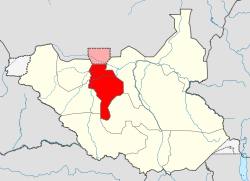Warrap (state)
| Warrap State واراب | |||||
| State | |||||
| |||||
|
Flag | |||||
 | |||||
| Capital | Kuajok | ||||
| History | |||||
| • | Independence of South Sudan | 2011 | |||
| • | Reorganisation of states | 2015 | |||
| Area | 45,567.24 km2 (17,594 sq mi) | ||||
Warrap, sometimes spelled Warab, was one of the original 10 states of South Sudan.
Location
The state was located in the Bahr el Ghazal region. It was bordered by the disputed region of Abyei to the north, by Unity State in Greater Upper Nile Region to the east, by Lakes State to the south, and by Western Equatoria State in Equatoria Region to the south west. The states of Western Bahr el Ghazal and Northern Bahr el Ghazal lied to the west.[1]
Overview
Warrap State had an area of 31,027 km². Kuajok was the capital of Warrap state, replacing Warrap. All states in Southern Sudan are divided in counties, each headed by a County Commissioner appointed by the President of the Government of Southern Sudan.[2]
| County | Area (km2) | Population Census 2008 | County Commissioner |
|---|---|---|---|
| Gogrial East | 3,890.55 | 103,283 | Akot Lual Akot |
| Gogrial West | 4,754.37 | 243,921 | Makuc Aruol Luach |
| Tonj South | 7,449.73 | 86,592 | Monydhiat Goor |
| Tonj North | 11,012.05 | 165,222 | Sijin Ayii |
| Tonj East | 3,990.61 | 116,122 | Biar Biar |
| Twic | 3,922.65 | 204,905 | Malek Ring Makuei |
The state belongs to South Sudan after a successful succession from Sudan on 9 July 2011.
People
The state was home to the Luanyjang, Twic, Jur-Man Anger, Bongo and Rek subtribes of Nilotic ethnicity. The Twic and Rek are Dinka tribes. The main cities in the state were Gogrial, Kuajok,Warrap town, Alek, Tonj, Romich, Thiet, Turalei, Akuon, and Panliet. Other villages included Abi, Abiet, Abyor, Ador, Again, Agum, Agurton, Aidu, Ajako, Ajung Shol, Akiar, Akop, Alak, Amett, Ayen, Bir Di, Bir' Qurub, Bop, Dan Ageir, Duqduq, Faier, Faiwal, Fan Ashir, Fing Dit, Gwurra, Jangyang, Kwoit, Liet, Lut, Madeir, Mading, Majon Yom, Maiwai, Majok, Makwoich, Malual, Marial Bai, Maryal, Mashraar Ragg, Meding, Meshra Ashol, Moing Jang, Molau, Nyang Fing, Pankier, Piny Dit, Powang, Rumbel, Urao, Waratit, Wun Liet, Wun Rog, Wunrock, and Zungumbia. (Ajak-kuai)' ( Aweng)' (Tuaralei)' (Wun-rock)' (Mayen-Abun), ( Akoc ) (Pan-Nyok), Consisted: Aruet, Goi one and Goi two, Akak, You, Alueth, Luit, Liang Arol, Panbai, Leilei, Pabiny, Arieu, Kuang-agok, Makuen-cetuer, Gony, Cawieu, Manyang, Mading-Luit, Payieweng, Agunyo, Pan-Arieu, Bodor, MIT-Piny, Lac-Akak, Anab-riang, Pan-abii, Tumakon, Thak-ayen, Adol-you, Malual-Kiir, Panameth, Pagai, Bar-Malual chan, Athiim were villages of Twic county and the rest were reserved.
Upon his death in 2010, NBA basketball star Manute Bol was buried in the Warrap state in his hometown of Turalei.[3]
The president of the Republic of South Sudan, Salva Kiir Mayardit, was a native of Warrap State.[4] Alek Wek, a prominent International model of South Sudanese and British citizenship, also hailed from the state.[5]
Government
The state constitution was adopted in 2008. Akech Tong Aleu was the last Governor of Warrap state. Madot Dut Deng was the last Speaker of the State Assembly.[6]
Religion
The main religion in Warrap State was Christianity, (Catholicism, Protestantism and other forms of Christianity). A sizable proportion of the population practiced African traditional religions.[7]
References
- ↑ Map of South Sudan
- ↑ South Sudan’s Kiir reshuffles cabinet, parliament of Warrap and E. Equatoria
- ↑ Basketball star Bol buried in south Sudan
- ↑ President Salva Kiir Comes From Warrap State
- ↑ Alek Wek Born In South Sudan And Resident In United Kingdom
- ↑ Deng, Madot. "Speaker of the State Assembly".
- ↑ Religions of South Sudan
